|
|
| South terminus: U.S. 169 in Osseo Previously --- U.S. 52 in downtown Minneapolis (Washington and Broadway) (1934-80); MN-100 in Brooklyn Center (1980-84) North terminus: MN-101 in Maple Grove (until 1988) Previously --- U.S. 52 in St. Cloud (1934-49); U.S. 10 in Sauk Rapids (1949-78) Legislative Route(s): 129, 239 Counties: Hennepin (previously included Wright, Stearns, and Becker) How numbered: From MDH correspondence from the 1930s, it appears that MDH planned to eventually upgrade this route and ultimately move U.S. 52 onto it. Construction of I-94 along this corridor occurred instead.
Authorized 1933, except for route through downtown St. Cloud, authorized 1949. Originally renumbered as MN-15 in St. Cloud and replaced by I-94 from St. Cloud to northern Hennepin County around 1978. Then, around 1980 the segment south of MN-100 to downtown Minneapolis along Osseo Blvd., Webber Parkway and Washington Avenue was turned back to the city (later becoming a county road in its entirety). By 1984, the Brooklyn Blvd. segment was CSAH 152, and in the 1988 highway swap, the remaining part was turned over to Hennepin County as CSAH 81. Comments: The original 1934 numbering plan had this route designated as MN-119. | ||||||
| South terminus: South St. Paul/St. Paul city limits Previously --- I-494 in Inver Grove Heights (1995-2021) North terminus: U.S. 52 in St. Paul (Concord Avenue exit from U.S. 52) Length: 1 Region: M Counties: Ramsey Constitutional/Legislative Route(s): 112 How numbered: Formerly part of MN-56.
Constitutional Route 53 south of South St. Paul city limits, north of city limits authorized 1933. Formerly part of MN-56 until completion of the Lafayette Freeway and turnback of part of 56 to Dakota County, renumbered to eliminate route continuity. Dakota County portion turned back 2021, remaining portion in St. Paul is sure to follow. Improvements: Paved since 1920s, still two or four lane city street. Part of Concord Avenue in South St. Paul and St. Paul | ||||||
| South terminus: U.S. 65 at Faribault North terminus: U.S. 65 in Lakeville (1934-58) Legislative Route(s): 101 Counties: Rice, Scott, Dakota How numbered: As an alternate to U.S. 65
This was the original direct (though not paved in the early days) trunk highway route, originally designated as an alternate to old U.S. 65, between Faribault and Lakeville. By the late 1950s, this road was paved and became a realignment of U.S. 65, and ultimately became the route of I-35. | ||||||
| South terminus: Upper Sioux Agency State Park North terminus: MN 23-67 at Granite Falls Length: 7.3 Region: SW County: Yellow Medicine Constitutional/Legislative Route(s): 340 How numbered: Originally part of MN-67 (see below) History: Since 1934 at least, this was part of MN-67 (Const. Rt. 67). (Before the mid-1930s, it appears that Rt. 67 may have followed one of the east-west county roads south of here). In 2019, a section of MN-67 just east of the state park began showing signs of damage from a landslide toward the nearby Yellow Medicine River. MnDOT closed the road and temporarily rerouted MN-67 traffic via MN-274 and CSAH 18, the first major east-west county road south of the impacted area. The agency conducted a feasibilty study to determine whether the damaged section could be rebuilt, and if not, what would be the best reroute for MN-67. Reconstruction of MN-67 in the damaged area was determined to be far more expensive than rerouting MN-67 over existing state and county routes, and making spot improvements to the roads used for the reroute where needed. Ultimately, MnDOT decided to reroute MN-67 via MN-274 and CSAH 2, which intersects MN-274 just north of Wood Lake. This change in routing for MN-67 also results in elimination of MN-274, with the short segment between CSAH 2 and Wood Lake being turned back to Yellow Medicine County. The portion of MN-67 between Granite Falls and the state park was retained as a trunk highway and designated MN-167. These changes are effective October 1, 2022. Improvements: Two lane paved highway. Comments: This is both the newest marked state route number and the newest Legislative route number in the trunk highway system. A new Legislative Route number was needed because MN-67 needs to use its Const. Rt. 67 designation continuously along the new alignment. I wonder a little why this route wasn't also turned back to the county, since MnDOT typically doesn't maintain trunk highways solely to access state parks. Note: the routine changes to Minn. Stat. 161.115 needed to add Legislative Route 340 and eliminate Legislative Route 274 did not pass the 2022 Minnesota Legislature, when the MnDOT omnibus bill didn't pass before the end of the session. Presumably, this will occur in 2023, and in the meantime, MnDOT's agreement on route transfer with Yellow Medicine County authorizes these changes. | ||||||
| South terminus: Iowa State Line (U.S. 169) at Elmore Nationally --- U.S. 75 S. of Tulsa OK North terminus: U.S. 53 at Virginia Previously --- U.S. 71 at International Falls (1931-34) Length (MN): 334 Region: SE, M, EC, NE Counties: Faribault, Blue Earth, Nicollet, Sibley, Le Sueur, Scott, Hennepin, Anoka, Sherburne, Mille Lacs, Crow Wing, Aitkin, Itasca, St. Louis Constitutional/Legislative Route(s): 5, 7, 5, 383, 3, 18, 35 How numbered: U.S. Route NHS: From south junction with MN-60 south of Mankato to the Twin Cities, then north to U.S. 53 at Virginia History: Constitutional Route its entire length except for freeway segment between I-494 and I-694. The U.S. 169 designation was extended north into Minnesota around 1931, and until 1934 followed Constitutional Route 11 from Virginia to International Falls (now U.S. 53). The segment between Mankato and St. Peter followed present-day MN-22 until early 1960s. While the other parts of this route are essentially unchanged, there have been numerous realignments of 169 in the Twin Cities area. Originally, 169 followed Flying Cloud Drive from the southwest to MN-100, (after CSAH-62, the "Crosstown Highway" was built by Hennepin County, 169 and U.S. 212 followed this new route to MN-100), north along 100, then northeast from 100 along Excelsior Blvd. and Lake Street to Lyndale in Minneapolis. 169 then turned north on Lyndale from Lake Street, past downtown, and through north Minneapolis. When U.S. 169 was first established, it followed original U.S. 10 (Broadway) west and northwest to Anoka. In 1934, this became U.S. 52, and U.S. 169 was routed north from downtown instead. At old MN-100 (later I-94/694), Lyndale became West River Road and followed the Mississippi River northwest toward Anoka. At Champlin, this road --- now a county route --- meets the current (and original) route of 169 (previously U.S. 52). The first major change came around 1981: the routing through Minneapolis was eliminated, and 169 was duplexed with 100 north to what was then U.S. 52 (current CSAH 81). It then was duplexed with 52 north to Anoka. U.S. 52 was later dropped from this alignment and the route was designated only 169. In the 1988 MnDOT-Hennepin County highway swap, the section of 169 between 100 and Osseo became CSAH 81, and the 169 designation was moved to the former CSAH 18 freeway between I-494 and CSAH 81. In 1996, Hennepin County completed reconstruction of CSAH 18 between the Minnesota River and I-494, and MnDOT constructed a bypass around the south side of Shakopee that connected to this route and the new Bloomington Ferry Bridge. The entire route was then redesignated U.S. 169. Most of the former U.S. 169 route from Shakopee to I-494 was previously duplexed with U.S. 212, its current designation. The section of former U.S. 169 between Shakopee and 212 has been turned back to Scott and Carver Counties as CSAH 69 and 101. Improvements: Paved by 1940. Between the junction with MN-60 south of Mankato and the Twin Cities, has been upgraded to at least expressway status over several stages. Freeway around Mankato and adjoining expressway sections completed early 1960s, along with bypasses of LeSueur, Jordan and Belle Plaine. Interchange at MN-19 south of Jordan completed 2002. Freeway around Shakopee built in the mid-90s along new alignment. An expressway segment through southern Hennepin County along old County 18 was converted to full freeway, with new interchanges at Pioneer Trail and Anderson Lakes Parkway. The I-494 interchange was reconstructed to eliminate all signals. North of the Twin Cities, it has been upgraded to expressway between Elk River and the southern end of Lake Mille Lacs, with bypasses of Princeton and Milaca built in the late 1980s. Super-2 between Hill City and Grand Rapids. On the north end, it is mostly expressway between Grand Rapids and Virginia. Most of these expressway stretches (and the freeway Shakopee bypass) outside the metro area are posted 65 mph.
Comments: Duplexed with U.S. 10 for about 15 miles northwest of Anoka. Exit Lists: Visit Adam Froehlig's exit lists for U.S. 169 in the Twin Cities area | |||||||
| West terminus: U.S. 53 N of Virginia East terminus: Fall Lake (6 miles east of Ely) where it becomes Lake CSAH 18 Previously --- MN-1 near Tower (1934-53) Length: 49 Region: NE Counties: St. Louis, Lake Constitutional/Legislative Route(s): 167, 35, 221 How numbered: As an extension of U.S. 169 (until U.S. 53 was added in 1934, U.S. 169 ran to International Falls). History: Authorized 1934 from Virginia to the junction with Constitutional Route-35 (former MN-35, now 135), where it terminated until 1953. Spur east of Ely authorized 1949 and originally designated MN-221 until 1953, when MN-169 was extended over MN-1 to Ely. Improvements: Paved by 1940. New segment east of Ely was paved by 1950. Comments: Runs concurrent with MN-1 for 26 miles from west of Tower to Ely. | ||||||
| West terminus: ND State Line (ND-59) East terminus: U.S. 75 E of St. Vincent Length: 2 Region: NW Counties: Kittson Legislative Route(s): 171 How numbered: Same as Legislative Route numbering
Authorized 1933. Originally was designated MN-73 and (by 1935) U.S. 59 until that route was constructed from Lancaster north to Canada in the 1950s (thus the number assigned by North Dakota). Improvements: Paved (as U.S. 59) by 1940. Comment: With the closure of the Noyes border crossing on U.S. 75, this road now carries Canada-bound traffic from U.S. 75 west to I-29. It's possible that this could become a new routing for U.S. 75 if that border closing is permanent. | |||||||
| South terminus: MN-11 near Pitt North terminus: Wheeler Point (Lk. of the Woods) Length: 12 Region: NW Counties: Lake of the Woods Legislative Route(s): 140 How numbered: As an extension of MN-72.
Authorized 1933. Originally designated MN-72 until the connection to the Canadian border crossing at Baudette now designated 72 was added to the trunk highway system around 1963. Improvements: South half of the former north segment of MN-72 paved by 1940, northern part paved by 1953. | ||||||
|
| West terminus: ND State Line (ND-5) East terminus: U.S. 59 N of Lake Bronson Previously --- U.S. 75 on east (1963-72) Length: 21 Region: NW Counties: Kittson Legislative Route(s): 324A, 328 How numbered: For its association with U.S. 75 History: West of U.S. 75, authorized around 1963. However, the bridge to North Dakota was not completed until the late 1960s. East of U.S. 75, authorized around 1972. Improvements: Gravel west of U.S. 75 until completion of the Red River crossing. The eastern segment was authorized over an already paved county road. Comments: The legislative route number 324A is used because the Commissioner of the Department of Highways (now Mn/DOT) administratively established route 324 as a connecting route from I-35 as authorized by law. (See this route discussion.) | ||||||
| Routing along 50th and 46th Streets | See MN-90 for other route details. Almost as complicated a history as 121. West terminus: MN-121 (50th St. at France Ave. ) 1959-69 Legislative route(s): 110 Counties: Hennepin History: Renumbered from MN-90 to avoid duplication with I-90, this originally ran along 50th and 46th Streets between MN-100 and Cedar Avenue (MN-36). After completion of I-35W, the segment east of I-35W was turned back. By 1969, the U.S. 65 designation was removed from Lyndale and replaced with 190. MN-121 was used to replace 190 along 50th (E. of France Ave.) and 46th Streets, though the eastern terminus was moved to I-35W. Later, 190 was eliminated on Lyndale north of 50th Street, and finally, the southerly portion of Lyndale was redesignated 121. | ||||||
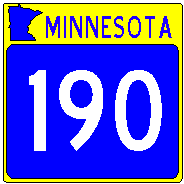 Routing along Lyndale Ave. | South terminus: I-35W at the Minneapolis/Richfield border North terminus: MN-121 at 50th and Lyndale (1980-85) Previously --- U.S. 12/52 and MN/U.S. 65 and U.S. 8 in downtown Minneapolis (1969-80) Legislative Route(s): 110, 105 How numbered: Unclear why the 190 designation was removed from 46th and 50th Streets and reused for old U.S. 65. (MnDOT likes to flip-flop route designations). History: After completion of I-35W in the mid-1960s, the U.S. 65 designation was removed from Lyndale about 1969 and replaced with 190. About 1978, 190 was eliminated on Lyndale north of 50th Street, and by 1980, the southerly portion of Lyndale was redesignated 121. | ||||||
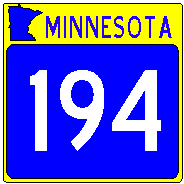
| West terminus: U.S. 2 NW of Hermantown East terminus: I-35 in Duluth Previously --- MN-23 in Duluth (1934-97) Length: 18 Region: NE Counties: St. Louis Constitutional/Legislative Route(s): 8, 208 How numbered: Originally designated MN-69 (1934-35), an apparently arbitrary designation, changed to MN-94 when U.S. 69 was extended into Minnesota. Re-numbered as 194 about 1959 to avoid duplication with I-94.
Constitutional Route segment is from U.S. 2 to U.S. 53. Other segment from U.S. 53 to downtown Duluth authorized 1933. The original alignment of this route in Duluth was from U.S. 53 down Central Entrance to 6th Avenue and then to 2nd and 3rd Sts. where it intersected MN-23/61. In 1997, this alignment was changed from 6th Avenue to Mesaba Avenue south to I-35, and the segments of MN-61 and 23 through downtown Duluth were eliminated. Improvements: Paved by 1940. | ||||||
| West terminus: U.S. 2 W of Bemidji East terminus: U.S. 2/71 S of Bemidji Length: 6 Region: NW Counties: Beltrami Legislative Route(s): 72 How numbered: This is an unusual designation. It is seemingly arbitrary, but is higher than the usual "arbitrary" numbers in Minnesota.
Actually part of original U.S. 2 through Bemidji (Constitutional Route 8). The L.R. 72 designation was extended south in the mid 1980s to allow leaving this route in the trunk highway system after completion of the U.S. 2 bypass. (Why not just give this a separate L.R. number? Who knows.) Improvements: Paved through Bemidji by the 1930s. Comments: Originally marked as "(MN-197) Thru City" on both ends, but this was eliminated in favor of a more standard, unbannered marking in 2004. This route functions essentially as a business route for 2 and 71, and probably would be appropriately marked as such. | ||||||
|
| West terminus: ND State Line (ND-200) East terminus: U.S. 2 NW of Floodwood Length: 204 Region: NW, NE Counties: Norman, Mahnomen, Hubbard, Cass, Aitkin Constitutional/Legislative Route(s): 176, 6, 31, 168, 138, 34, 162 How numbered: To correspond with ND 200 (see below)
Constitutional Route segments between U.S. 75 and MN-9, MN-9 and U.S. 59, and MN-371 and MN-6. Other segments authorized 1933. Previously numbered 116 (ND to U.S. 75); 31 (U.S. 75, later ND State Line to MN-92, later to U.S. 371); 92 (between 92 and U.S. 71, then later to 371); 85 (U.S. 71 to U.S. 371) and 34 from 371 to U.S. 2. Redesignated around 1969. Improvements: Mostly gravel in 1940. By 1953, paved except a segment west of Zerkel (92) and the portion east of MN-6. All paved by 1960. Comments: Part of a link of state routes with this number stretching from Idaho to Minnesota. My opinion (unsubstantiated) is that the number 200 was derivative of this route's previous marking across Montana, 20. These routes across the four states (actually five, since the route was also marked in Washington for a time) were strung together about 1969. The states involved applied to AASHO for approval of a U.S. route (unspecified number), but were denied because the road does not connect significant population centers. | ||||||
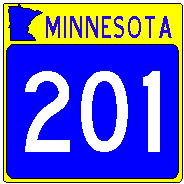 | South terminus: U.S. 10 in Elk River North terminus: U.S. 169 just north of Elk River Legislative Route(s): 187 Counties: Sherburne How numbered: Derivative of its former designation, T.H. 101
A short extension of old MN-101 that ran through Elk River from U.S. 10 north to U.S. 169. Eliminated around 1985. | ||||||
| Original designation for current U.S. 2 Business (see for route details) through East Grand Forks after completion of the U.S. 2 bypass in the mid 1960s. Marked as such about 1965-68. | ||||||
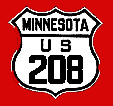 | ORIGINAL 1934 NUMBERING PLAN West Terminus: U.S. 218 [10] at Motley East Terminus: U.S. 61 at Carlton Constitutional/Legislative Route(s): 2 Final 1934 Designation: U.S. 210 Current Designation: MN-210 Comment: The initial 1934 numbering plan would have routed U.S. 10 along former U.S. 10S between St. Cloud and Fargo. For the north leg, U.S. 8 was initially considered, though the proposal became extension of U.S. 218 northwest of St. Cloud along former U.S. 10N. As a result, U.S. 210 (an original U.S. route) would have no longer ended at its "parent" route. So, the marking U.S. 208 was proposed, while U.S. 8 was still in contention. When U.S. 10 was actually routed along former U.S. 10N instead, U.S. 210 kept its identity. | ||||||
| Ran from U.S. 10 at Brainerd to U.S. 61 at Carlton. An original U.S. route in Minnesota, redesignated MN-210 (see for route details) around 1973. In 1934, nearly was renumbered U.S. 208 until introduction of U.S. 52 resulted in more changes in the adopted number scheme. | |||||||
| West terminus: ND State Line (ND-210) East terminus: MN-23 E of Carlton Previously --- U.S. 10 at Staples (1955-73) Original routing: U.S. 61 at Carlton to MN-23 (1947-55) Length: 228 Regions: WC, EC Counties: Wilkin, Otter Tail, Todd, Hubbard, Corw Wing, Aitkin, Carlton, St. Louis Constitutional/Legislative Route(s): 3, 36, 183, 2, 215 How numbered: Originally as a westward extension of U.S. 210, and part of current routing was originally designated U.S. 210 NHS: From junction with U.S. 10 at Motley east to I-35 at Carlton
Constitutional Route segments from Breckenridge to Fergus Falls, Fergus Falls to U.S. 59, and Motley to Carlton. Between U.S. 59 and U.S. 10, authorized 1933. The portion of MN-210 from Breckenridge to U.S. 10 at Staples was originally designated MN-3, then redesignated MN-210 in the 1950s at the same time that the original MN-210 east of Carlton was renumbered MN-39. The U.S. 210 segment between Brainerd and Carlton was renumbered MN-210 around 1973. The segment from Carlton to MN-23 was originally designated MN-210, then when the segment west of Motley was re-numbered MN-210 in the mid-50s, the original segment was redesignated MN-39. When U.S. 210 was decommissioned, this original segment re-assumed the MN-210 designation to match the rest of the now-consolidated route. Improvements: In 1940, there was a gravel section between highways 29 and 10. All paved by 1953. | |||||||
|
| West terminus: SD State Line (U.S. 212) W of Ortonville East terminus: U.S. 169 and MN-62 at Eden Prairie Nationally --- Yellowstone N.P. WY Previously --- U.S. 12 at Willmar (1926-33); Wisconsin border at Stillwater (1934-35); U.S. 12-52 in St. Paul (1935-82) Length (MN): 161 Regions: SW, SE, M Counties: Lac Qui Parle, Chippewa, Yellow Medicine, Renville, McLeod, Carver, Hennepin Constitutional/Legislative Route(s): 155, 12, 260 (Until completion of the U.S. 169 Shakopee bypass that assumed Constitutional Route 5, the legislative routes east of Chaska would have been 51 and 5.) How numbered: U.S. Route NHS: Entire length in Minnesota History: Constitutional Route from U.S. 75 to MN-41. Formerly part of Constitutional Route 51 from MN-41 to former alignment of U.S. 169 near Shakopee, and Constitutional Route 5 to I-494 (with new U.S. 169 highway alignment around Shakopee and Bloomington, these legislative routes have moved). SD State Line to U.S. 75 authorized 1933. L.R. 260 alignment authorized 1949 and modified in 1970s to allow proposed new U.S. 212 to be built from Cologne to Eden Prairie. U.S. 212 was an original U.S. route, though the portion from the SD State Line to U.S. 75 ran over county roads until 1933. As originally laid out in 1926, U.S. 212 ran from Montevideo east and northeast (via current MN-23) to Willmar, where it ended at U.S. 12. By 1934, it was moved onto its current alignment (except for the new freeway section near Chaska, see discussion below) to the Twin Cities, and for one year it extended east of St. Paul to the Wisconsin border where it ended. This portion became MN-212 in 1935. In the Twin Cities area, until around 1980 U.S. 212 was concurrent with U.S. 169 to Lake Street at Lyndale, then followed Lake Street east into St. Paul where it becomes Marshall Street. U.S. 212 followed Marshall St. all the way to downtown St. Paul where it joined 7th Street. See comment below for original proposed 1934 routing. An interim alignment (early 1980s) in St. Paul turned 212 north from Marshall St. onto Snelling (MN-51), then east to downtown along University (U.S. 12/52) where it became MN-212 at the same intersection. Maps published around this time indicated that the MN-212 designation would have been moved west to the current point where U.S. 212 ends. However, the numbered designation was dropped altogether around 1983, and MN-212 east of downtown became MN-5. From the time the 212 designation was dropped until 1988, Lake and Marshall from Hiawatha to Snelling was an unmarked state trunk highway. With these trunk highway turnbacks, U.S. 212 no longer touches its parent route, U.S. 12. Improvements: All paved by 1940. Divided highway segment near Norwood built before 1953. Future Improvements . In west-central Minnesota, from Hector to MN-22, the road will be rebuilt with passing lanes beginning 2009. Comments: The original 1934 numbering plan routed U.S. 212 east along what became MN-5 through Bloomington, and into St. Paul via West 7th Street. This part isn't illogical, but the very odd part of this original routing plan brought U.S. 212 from Chaska north to Chanhassen via what became MN-101. | ||||||
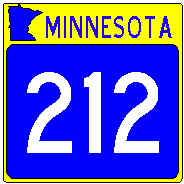 | West terminus: U.S. 52 and 212 in downtown St. Paul (W. 7th at Robert) East terminus: Wisconsin state line at Stillwater (1935-83) Constitutional/Legislative Route(s): 102, 109, 45 Counties: Ramsey, Washington How numbered: As the extension of U.S. 212
When U.S. 212 was extended along its current alignment from western Minnesota to St. Paul in 1934, it was extended eastward to the Wisconsin border (with no corresponding route in Wisconsin). In 1935, at the junction of 7th Street and Robert Street (U.S. 52) in downtown St. Paul, eastbound U.S. 212 became MN-212, then followed the current route of MN-5 and 36 to Stillwater. The 212 designation continued to the Wisconsin border. This route was renumbered MN-5 around 1983. That year, the Minnesota highway map showed that MnDOT had initially planned to replace U.S. 212 between its current end in Eden Prairie and St. Paul with MN-212. Instead, the route number was totally dropped (though much of the route remained under state control as an unnumbered route, and stayed that way until 1988). | ||||||
| West terminus: U.S. 169 in Hibbing East terminus: U.S. 53 at Virginia Legislative Route(s): 216 Counties: St. Louis How numbered: Same as its legislative route number
From 1949 to 1963, original designation for western leg of MN-37 | ||||||
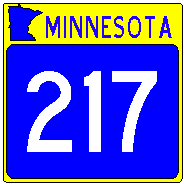
| West terminus: U.S. 71 at Littlefork East terminus: U.S. 53 at Ray Length: 17 Region: NE Counties: Koochiching Legislative Route(s): 217 How numbered: Same as its Legislative Route number. History: Authorized 1949. Improvements: Paved before 1960. | ||||||
| South terminus: U.S. 65 in Owatonna Previously --- U.S. 218/U.S. 12-52 in St. Paul (1934-35) North terminus: Merrifield (north of Brainerd) Previously --- U.S. 210 in Brainerd (1934-49) Constitutional/Legislative Route(s): 1, 115, 112, [multiplexed with U.S. 52 and its fellow travelers over L.R. 104 and 3 from St. Paul to west of Big Lake], 209, 233 Counties: Rice, Dakota, Ramsey, Hennepin, Anoka, Sherburne, Benton, Morrison, Crow Wing How numbered: As an extension of U.S. 218
See U.S. 218 discussion below for one-year designation of the Owatonna-St. Paul segment as U.S. 218. After elimination in 1934 of U.S. 55 and realignment of U.S. 65 from St. Paul to Minneapolis, U.S. 218 was extended north from Owatonna along U.S. 65, originally as U.S. 218 and a year later as MN-218. From Farmington, it ran north along what is now MN-3 and Robert Street all the way into downtown St. Paul. (The original route of U.S. 65 north of Wescott (today's Eagan) became MN-88, later 49 and now 149). The MN-218 designation was multiplexed from downtown St. Paul with U.S. 12/52 and MN-56, and followed the route of U.S. 52 through Minneapolis, Anoka, and Elk River. It left U.S. 10/52 west of Big Lake along the route that is now MN-25, and ran to Brainerd. The most northerly leg of this route north of Brainerd was added around 1949. Around 1963, this designation was eliminated and became MN-3 from Faribault to St. Paul and MN-25 north of U.S. 10. Part of what was marked as MN-218 was originally marked as a U.S. 218 extension as far north as St. Paul from 1934 to 1935, as shown on the 1934 Minnesota Highway Map. Also, as discussed on the U.S. Highways page under the listing for U.S. 208, around 1934 there were maps published with route numberings that were never actually posted. The same map that shows U.S. 208 along the U.S. 210 alignment also shows U.S. 218 extending northwest from St. Cloud along the former U.S. 10N (later U.S. 10) alignment to Moorhead. It also shows U.S. 10 along the former U.S. 10S alignment that then became U.S. 52. | ||||||
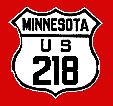 Proposed route extension to Moorhead | ORIGINAL 1934 NUMBERING PLAN West Terminus: U.S. 10 [52] at Moorhead or Fargo ND East Terminus: U.S. 10-12-55 [12-52] at St. Paul (this extension only) Constitutional/Legislative Route(s): 2, 37, 3, 62 Final 1934 Designation: U.S. 10 Current Designation: U.S. 10 Comment: While U.S. 218 was extended from Owatonna to St. Paul from 1934 to 1935, the original 1934 marking plan showed U.S. 218 extended northwest from St. Paul along Const. Rte. 62 to Anoka and then northwest on Const. Rte. 3 (U.S. 10) to St. Cloud. Then, it would have followed the former route of U.S. 10N (today's U.S. 10) to Moorhead (or Fargo...I'm not sure where the west end of 10N/10S was). When U.S. 52 was extended into the state, the U.S. 218 extension north of St. Paul was eliminated, and U.S. 10 routed along this path instead. North of St. Cloud, former U.S. 10N (instead of 10S) became U.S. 10. However, this proposed extension of 218 lived on as MN-218, which was shifted to the former path of U.S. 10 through St. Paul, Minneapolis, and the northwest suburbs, also the route of new U.S. 52. The new state route followed U.S. 52 to west of Big Lake, then north along what is now MN-25 to Brainerd. | ||||||
|
| South terminus: Iowa State Line (U.S. 218) S of Lyle Nationally --- U.S. 61 N of Keokuk IA North terminus: I-35 at Owatonna Previously --- U.S. 12-52/MN-218 in St. Paul (1934-35) Length: 46 Region: SE Counties: Mower, Dodge, Steele Constitutional/Legislative Route(s): 40 How numbered: U.S. Route History: U.S. 218 was probably an original U.S. route, since it is shown on the 1927 Minnesota highway map. Improvements: Paved before 1940. Currently two-lane over most of its length. Bypasses Austin along the route of a former separate bypass originally designated MN-252. Comments: See MN-218 and proposed U.S. 218 extension discussion above. It is unusual in that it crosses its parent route (U.S. 18 in Iowa) and runs perpendicular to it. Its original designation in Iowa south of U.S. 30 was U.S. 161, and in general this route would have more properly been designated as a U.S. x61 or x65. |
Travel On...
You are at Routes 152-218 | ||
Lastupdated July 9, 2022